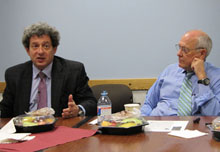Event
Holtzman says digital ‘impulsivity’ and ‘permanence’ threaten privacy

October 12, 2010 — Shorenstein Center Director Alex S. Jones introduced David Holtzman as “one of the most authoritative voices” in the area of digital privacy. Holtzman is the former CTO of Network Solutions and author of Privacy Lost: How Technology Is Endangering Your Privacy.
Holtzman opened his Shorenstein Center talk by asking the audience how they defined “privacy.” Answers ranged from “physical exclusion” to a “separate psychological space.” Holtzman added that the loss of privacy now includes a loss of dignity and identity as well because you are “giving up information in a way where you feel you have no choice.”
Privacy has been affected by both “informational and interactivity” changes in technology, Holtzman explained. Digital communication, he said, has the “impulsivity of oral communication and the permanence of written communication.” With the transition from analog to digital data, information is now very inexpensive to collect and store, Holtzman said, emphasizing that “if you said it somewhere, it’s going to come back.”
The three levels of data, Holtzman enumerated, are collecting, analyzing and predicting. While data has been collected as long as the Internet has existed, only with the capabilities of digital referencing and tagging is that data able to be analyzed. “We’ve moved beyond the simple collection of data,” Holtzman said, “to an inference of data which I think is more frightening.” Beyond that, he explained, is the ability for artificial intelligence to take predictive measures, so that “what you’re thinking and what you may do someday is actually now being evaluated.” “This isn’t science fiction,” he said. “This is very real.”
Holtzman suggested “pseudonymous identities” online as a way to help preserve privacy in the future, so that everyone would have separate online and offline identities. However, he warned that “Congress hates this idea” because a new “digital currency” might emerge. “Government fundamentally doesn’t like the idea that they can’t track things when they need to,” he said.
This article was written by Janell Sims and the photos taken by Leighton Walter Kille, both of the Shorenstein Center.